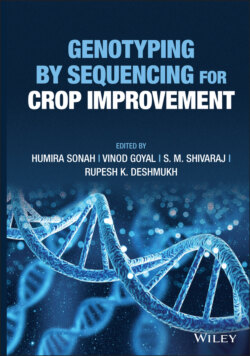Читать книгу Genotyping by Sequencing for Crop Improvement - Группа авторов - Страница 18
1.3.2 Polymerase Chain Reaction (PCR)‐based Markers 1.3.2.1 Simple‐Sequence Repeats (SSRs)
ОглавлениеSimple‐sequence repeats (SSRs) (Litt and Luty 1989) are also known as microsatellites or short tandem repeats (STRs) or simple sequence length polymorphism (SSLP). These are widely used markers and are also referred to as the mother of all the markers. These are STRs, generally of one to eight nucleotide length. These are found dispersed throughout the genome and are hypervariable. These repeat regions are flanked with unique sequences that are highly conserved. The flanking unique sequences are used to design complementary primers which can be assayed with PCR. SSRs are highly polymorphic and codominant markers. These show polymorphism as a result of the variable number of repeat units. Before the era of genome sequencing, it was difficult to develop SSRs due to the extensive cost and labor involved in the identification of repeat regions and flanking unique sequences. However, with the availability of genome sequences of several organisms, the development of SSR has become very easy which involves in silico identification of STRs, designing of SSR from flanking unique sequences, and validation through experimentation. SSR markers have shown immense application in population genetic analysis, gene mapping, and cloning due to their abundance in the genome and high polymorphism, and very high reproducibility across labs. SSR‐based linkage maps have been developed in several important crop plants such as rice (Temnykh et al. 2000; McCouch et al. 2002; Orjuela et al. 2010), wheat (Roder et al. 1998), maize (Sharopova et al. 2002), potato (Milbourne et al. 1998), etc.
